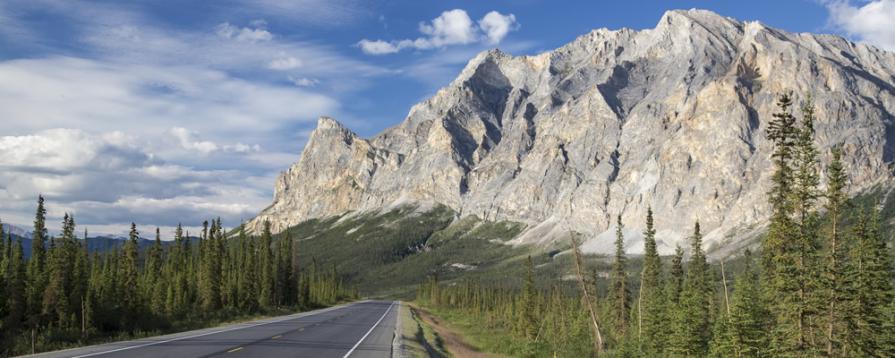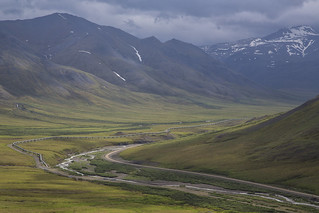
2025 Dalton Highway Artist-in-Residence
The application window for the 2025 Dalton Highway Artist-in-Residence opportunity is open through March 28, 2025.
The selected artist will be announced in the spring, and all applicants will be notified. If you are interested in applying in the future, look for an announcement and instructions in early in the year.
This year, the BLM Alaska and Toolik Field Station are offering a collaborative Dalton Highway Artist-in-Residence opportunity. It will run for seven to ten days between June and early September 2025, with exact dates at the discretion of the artist. During the residency, the artist will have the opportunity to travel much of the Dalton Highway, speak with land managers and scientific researchers, and pursue their artistic discipline amid Alaska’s inspiring landscapes. Artists are encouraged to split their time between one of the BLM cabins or campgrounds and at the University of Alaska Fairbanks Institute of Arctic Biology’s Toolik Field Station, and/or at a remote, backcountry location, depending on the interests and outdoor experience of the selected artist. Artists can be hosted for up to five days at a BLM facility, as well as up to five days at Toolik Field Station.
The BLM will provide the selected artist with transportation from Fairbanks to the residency location(s) as well as provide housing and/or camping equipment, satellite phone, and emergency equipment (including first-aid kit). Transportation to Fairbanks is the responsibility of the selected artist. While at Toolik Field Station, artists will be provided with meals, housing and will have the opportunity to connect with researchers currently working at the field station.
Travel along the Dalton Highway provides a rare opportunity to traverse a remote, unpopulated part of Alaska to the very top of the continent.
The Dalton Highway is one of the most isolated roads in the United States. Built during construction of the trans-Alaska oil pipeline in the 1970s, this mostly gravel highway travels through rolling, forested hills, across the Yukon River and Arctic Circle, through the rugged Brooks Range, and over the North Slope to the Arctic Ocean. Along most of its length, you'll see no strip malls, no gift shops, no service stations — just forest, tundra, and mountains, crossed by a ribbon of road and pipe.
As you move north along the highway, boreal forest gives way to arctic tundra, with opportunities to see moose, caribou, Dall sheep, black and brown bears, muskox, wolves, and lynx. Every spring, migrating birds such as the arctic tern, tundra swan, and blue throat arrive for the summer nesting season. Additional highlights include the historical mining village of Wiseman and the Arctic Interagency Visitor Center in Coldfoot. The BLM manages a swath of public lands along the highway from the Yukon River to the north side of the Brooks Range. These public lands are adjacent to Gates of the Arctic National Park and Preserve and the Kanuti, Yukon Flats, and Arctic National Wildlife Refuges.
The Toolik Field Station is a leading, year-round Arctic observatory and research and education facility, dedicated to addressing local and global challenges of a rapidly changing Arctic. The station is located on the northern foothills of Alaska's Brooks Range and operated by the Institute of Arctic Biology at the University of Alaska Fairbanks with cooperative agreement support from the U.S. National Science Foundation's Division of Polar Programs. Toolik aims to promote a greater understanding of the Arctic by safely, sustainably, and equitably fostering research and education in response to the needs of scientists and the larger community.
For inspiration, check out the BLM Dalton Highway Flickr album.
Interested in being the next artist?
- Artist Expectations
-
Participating artists are asked to give at least one public demonstration or presentation during the course of their residency. Both the Toolik Field Station and Arctic Interagency Visitor Center have facilities and welcoming audiences.
As part of the program, the artist is asked to donate to the BLM and Toolik Field Station the use of an original piece of artwork from the residency. The artist will have to complete a Volunteer Service Agreement where they have the option to either retain the copyright and the original artwork or allow the BLM to retain the original artwork for use in exhibits, for educational purposes, and/or by non-profit partners for items such as postcards or posters. If the artist chooses to retain copyright and original artwork, they will have to fill out a licensing contract.
- Artist Selection
-
The BLM is committed to supporting artistic efforts from all mediums that support public lands. The selection process is collaborative, with a jury that reviews and ranks all complete applications, discusses rankings, and comes to a consensus on the final selection. Artists must be 18 or over.
To visit Toolik Field Station, artists must comply with current health and wellness policies in place at this remote location.
Factors considered by the selection committee:
How well does the project embody the importance of public land? How strong is the artistic sample? Does the candidate have a sufficient level of experience and knowledge to safely complete the residency? Has a previous artist in residence used a similar media recently? If yes, is the proposal unique?
Applicants will be notified in May.
- How to Apply
-
Application materials are due to the BLM by Friday, March 28, 2025.
Attention: Brian Perry
Central Yukon Field Office
222 University Ave
Fairbanks, AK 99709Email: [email protected]
Include the following materials in application packages:
Artist's Preferred Dates of Residency (7-10 days, June–early September)Artwork List and Samples: Provide a one-page list of work samples submitted with title, medium, date, and other relevant information that will assist in the evaluation of your work (printed, or PDF/MS Word document format). Use your last name and image number in the file name. (For example: Smith_Image01.jpg)
- Visual Artists (photographers, painters, sculptors, weavers, etc.): Up to 5 images of work, emailed, shared on a digital drive, or mailed as prints or digital files. Digital submissions must be in JPG or TIFF format, not larger than 2 MB each.
- Videographers or Performing Artists: At least two productions or segments thereof, not to exceed to 5 minutes total.MPEG file format, emailed, or share a link to the video online such as YouTube, Vimeo, or a personal website.
- Writers or Poets: Up to 10 pages of writing samples, double-spaced. Printed and mailed, or emailed or share a link to the files. Acceptable file formats are MS Word, PDF, HTML.
- Auditory Artists (composers, sound recorders, etc.): At least two productions or segments thereof, not to exceed to 5 minutes total. Submit as WAV, MP3, WMA, or MPEG MPEG file format, emailed, or share a link to the file.
Project Proposal: No more than one page in length (printed, or PDF/MS Word document format). Proposal should include:
- Your experience with outdoor activities in Alaska or similar climate
- Why you are interested in a BLM artist residency
- A description of your potential artistic product(s) and relevance of your project to the missions of the BLM and the Toolik Field Station
- Potential for development of your artistic growth/interests
- A description of a public presentation to be delivered during the residency or within 6 months of your project

